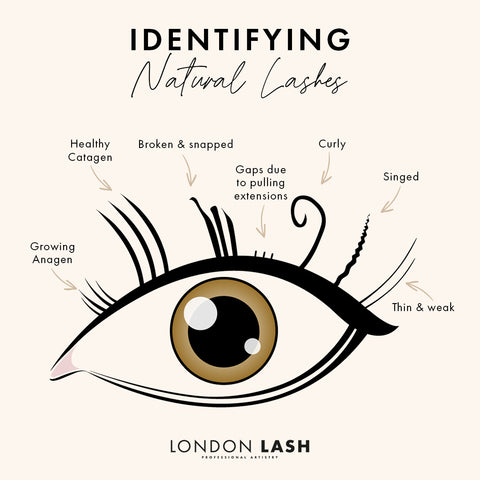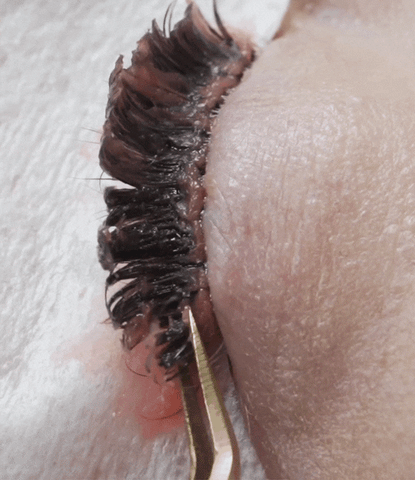FREE STANDARD SHIPPING FOR ORDERS OVER $170!
FREE STANDARD SHIPPING FOR ORDERS OVER $170!
New In
Glues & Liquids
Ebooks

How Lash Extensions Can Cause Damage: Part 2
September 20, 2023 4 min read
With the Right Application, No Damage Will Be Caused. Well, That is if Your Clients Are as Informed as You…
In the grand scheme of things, eyelash extensions are still a pretty new treatment. Owing to that, advice and education changes all the time so if you’re not keeping your knowledge up to date, you’re more likely to cause damage to the natural lashes due to improper application or practice. Even when your education is fully up to scratch, there are enough myths and misconceptions out there to misguide your clients, so it’s important that you educate each and every client on how they can avoid inadvertently causing damage to their natural lashes after getting eyelash extensions.
If you haven’t checked it out yet, take a look at part 1 of this mini-series to find out how you can avoid damage with lash extensions, or read on to find out what our clients might be doing (or not doing) that can cause damage to their natural lashes.
Rubbing and Pulling
Eyelash extensions are stuck to the natural lashes with cyanoacrylate-based lash extensions glue. Despite being a super small amount of glue, it’s strong enough to keep those lashes in place for weeks and weeks, as long as the correct lash pre-treatment routine has been carried out.
Rubbing and pulling on lash extensions can affect retention by breaking the glue bonds, but you’d be surprised just how strong those bonds can be! The real danger of rubbing, pulling, or picking at lash extensions isn’t that the extensions will fall off, but that the natural lashes will be pulled out at the roots. It goes without saying that this results in gappy lashes, but can also permanently damage the hair follicle, meaning that it will never grow back.

We can’t always change our clients' behavior, but by educating them, we at least stand a chance of them not picking at or rubbing their extensions! If you have a client who can’t help but pull at their lash extensions due to anxiety, compulsive behavior, or for any other reason, it may be a good idea to either give them a break from lash extensions or advise that they swap to a different treatment such as a lash lift. Lash and eye health should always come before the aesthetic value that lash extensions bring.
Lack of Proper Hygiene
We mentioned myths and misconceptions in the introduction, and this is probably one of the biggest areas where misinformation has spread. To give you a better idea of how this particular area of misinformation came to be so prolific, we’re going to take you back to the early days of lash extensions.
A Historical Segue
Lash extensions used to be made from organic materials such as mink fur and silk. These lashes led to more allergic reactions, weren’t even slightly vegan friendly, weren’t uniform in the way that they looked, and with these lashes, you couldn’t get them wet if you wanted to maintain the way they looked and not completely ruin them.
These days, eyelash extensions are made from synthetic fibers and are ‘mink’ and ‘silk’ by name only, so that there is some kind of differentiation between the way each type of lash extension looks.
Back to Hygiene…
Though the fibers have changed, the perception remains – it’s unbelievably common for clients (and even some Lash Techs) to believe that they cannot get their lashes wet, otherwise, they will fall out or will be ruined. The proper aftercare advice is this:
- Wait 24 hours after your appointment* before getting your lashes wet. This allows plenty of time for your lash glue to cure completely
- Wash your lashes every day with a specially formulated lash shampoo. You can use a cleansing brush or your fingertips, but be careful not to rub too hard
- Rinse the lashes thoroughly – lukewarm or cool water is best in terms of comfort
- Pat the lashes dry with a towel
- Brush the lashes through with a mascara wand to keep them looking fluffy

*If your client’s lifestyle sees them coming into contact with water soon after treatment, try using Superbonder Lash Sealant to cure their lash glue. They will then be able to get their lashes wet straight away without jeopardizing their lash retention.
Not following aftercare advice means that not only will their retention suffer, but they open themselves up to conditions such as blepharitis and an increase in Demodex mites due to the buildup of sebum and dead skin cells that would have been washed away, had they cleaned their lashes.
Removing Lashes at Home
It should be obvious that using anything marked ‘professional use only’ as someone who is not, in fact, a professional can lead to damage, but still, we see many instances of people trying to remove eyelash extensions at home.
Their first port of call is often to try and remove the lashes by soaking them in oil, which doesn’t actually work and can cause damage due to the subsequent pulling of the lashes, which they do with the expectation that the lashes will slide off.
Once this doesn’t work, they may seek a professional lash extensions remover, which is where untold damage can be done. Lash extensions glue remover is tasked with breaking down the lash glue so that the extensions can slide off – their main ingredient tends to be acetone, which should not be anywhere near the eyes unless you know exactly what you’re doing with it and how to control it.

Yes, remover can burn if it gets into the eyes, but it can also lead to blindness, so when we label something 'professional use only’, we mean it!
Offering lash removal services to clients is important, and offering them education on why they MUST return to you if they need their lashes removed is vital. Having lash extensions removed is a quick procedure and it’s actually pretty relaxing, as long as a Lash Technician is doing it for you.
As Lash Technicians, it’s not just our responsibility to stay at the forefront of lash trends, it’s also paramount that we stay updated with lash advice and education, and to pass that knowledge on to our clients. Read lash blogs, take further training courses, and never assume that your clients know how to take care of their lashes!
Subscribe
Sign up to get the latest on sales, new releases and more …










